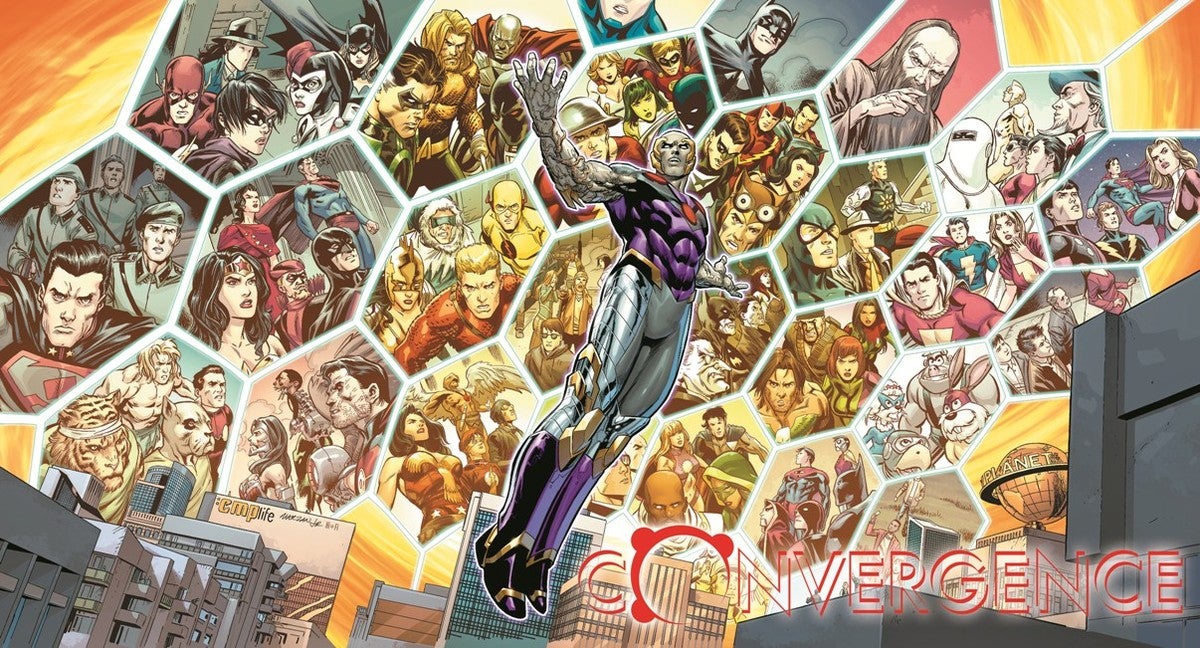
Videos by ComicBook.com
Or, rather, by Brainiac, who will be Telos once Convergence starts and he merges with an as-yet-unidentified planet that we’re guessing will turn out to be less a planet and more Vanishing Point, home to Booster Gold and Rip Hunter, Time Master.
In any event, an expanded version of Monday’s teaser was released today and it gives us a lot of new information to chew on.
These worlds, as we touched on earlier in the week, are what we saw a bit of at the end of the Superman: Doomed miniseries/event which, with a main spine and a number of monthly series wrapped around it, seems to be structured in a fairly similar fashion to Convergence.
You can see that image at right, and compare it to the Convergence teaser image to see just how similar the “peeks” into the alternate earths are.
Here’s the first batch of observations, made based on the original teaser which had a much more limited selection. We won’t belabor those by going over them again here, but certainly there’s some interesting stuff there.
Still, the really big ones came today. There were also one or two more “random Earth with unrecognizable, non-super people on it” images, but those we won’t speculate on. Our guesses about Earth Prime and some others were about all the mileage we were going to get out of panels like that.
So…what’s new?
Another New Crisis
Last time around, we noted that Earth-2, home to the Justice Society, and Earth-Four, where the characters of Charlton Comics ended up when DC purchased that company, were a part of this mosaic as well. With the addition this time of Earth-S, Earth-X and the pre-Flashpoint “Clutter Earth” that took Earth-1’s place, it now appears that all of the worlds that were folded into the DC Universe at the end of Crisis on Infinite Earths are present and accounted for.
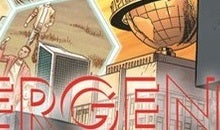
LexCorp tower, as it was redesigned during the John Byrne/post-The Man of Steel era of Superman, which seems a likely candidate to have many of its features pop up in Convergence since it was, in many ways, very different from most interpretations of Superman that came before and after.
It looks at first glance like it might be part of the world we’re peeking into with the young guy taking a photo on his cell phone…but that seems unlikely since both the building’s angle and its size would be totally wonky if that were the case. It seems more likely that, in spite of not having appeared in the original version of the image, LexCorp’s corporate headquarters has been added to the skyline of Metropolis on the Bottle City Planet.
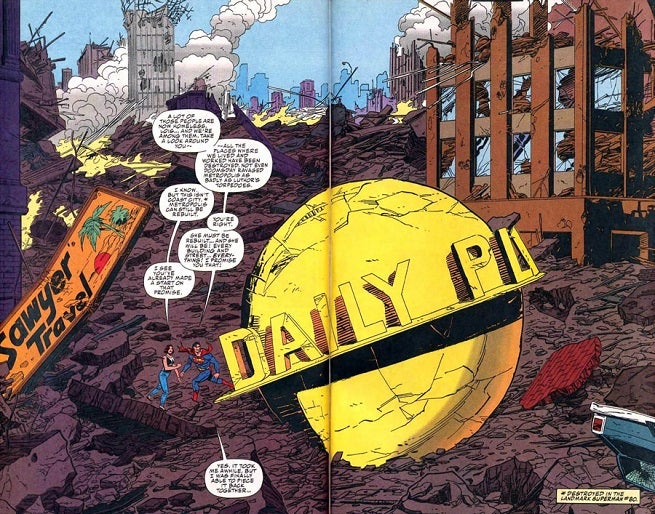
It’s also odd because it’s at odds with the Daily Planet globe; during the post-Crisis era, when that LexCorp building was a fixture in the Metrpolis skyline, the Daily Planet globe was primarily depicted as a smooth, golden circle without geography, latitude and longitude on it. You can see it above, amid the wreckage of Metrpolis in Action Comics #700 (it got better).
I stopped reading Superman regularly in around 2000, so it’s possible that in the intervening years it became common for artists to depict the globe more like the one above and I never noticed, but in my mind’s eye, the time of that globe and that LexCorp building don’t go together.
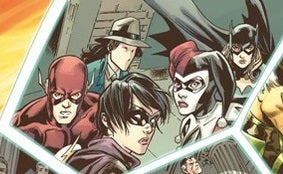
New Earth was what they called the world created at the end of Infinite Crisis, by once again folding in elements of the multiverse that Superboy Prime and the like had briefly called into being during that story. Basically, it’s the world on which most of DC’s stories happened between 1986 and 2011.
Recognizable faces from that world appearing here for the first time since the New 52 relaunch include Wally West as The Flash (hey! He’s white in this reality), Renee Montoya as The Question (hey! She’s…on a page of a DC comic!), Cassandra “Black Bat” Cain, Harley Quinn classic and Stephanie Brown as Batgirl.
Who’s that chin?

Maybe even Barry as a Blue Lantern? That’s an idea some people really latched onto.

Who knows what reality this could be.
Given the absence of a yellow outline around the bat, one could guess that it’s something like the Frank Miller/Dark Knight universe, but that would be a bit of a stretch just from a picture of Batman standing around.
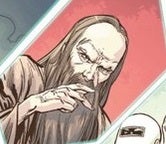
I believe that’s the Wizard Shazam (not to be confused with the superhero Shazam!, formerly known as Captain Marvel, who gets his powers from the Wizard).
Again, having a shot of just one character who isn’t doing anyting in particular makes it difficult to speculate about meaning.
Could this represent the Rock of Eternity as a separate locale/universe? That could help explain why he’s not with his pals a few entries down.
One Million
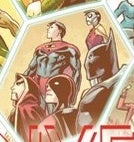
If it isn’t Vanishing Point or Oa (two popular choices), the “planet” with which Brainiac merges could turn out to be either the world of DC One Million, which is like ours except massively technologically advanced, or perhaps Solaris himself.
You’ll see Hourman just below Superman One Million in that image — he was the character who got his own ongoing series that spun out of the event story and would be an odds-on favorite to get a two-issue story if they were to focus on solo characters rather than whole worlds.
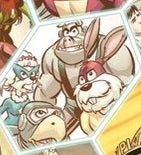
Captain Carrot and the Amazing Zoo Crew, a comic book based on funny animal superheroes, has rarely crossed over with the DC Universe proper…but during a Crisis-level event, you’re likely to see at least a bit of them. This one appears to be no different, as the former Earth-C is clearly evident here.
Captain Carrot has been chosen as one of the champions to fight for the mutiverse in Grant Morrison’s The Multiversity, so it’s hard to imagine that the presence of this Earth doesn’t “mean” something. That said, it shares something in common with the next Earth we’ll mention…!

The world of The New 52: Futures End is pretty clearly represented here by the evil cyborg versions of our heroes infected by Brother Eye in Futures End #0.
On the one hand, that shouldn’t be too surprising since Futures End will lead into Convergence. On the other hand…
…well…aren’t the worlds seen here supposed to be ones that have already ended?
This has implications, actually. Does this “spoil” the ending of Futures End by lumping the future that story is attempting to avert in with other stories of worlds that no longer exist? The original USA Today story suggested that the worlds we’ll be seeing in Convergence are essentially orphaned timelines from destroyed universes.
If so…good guys win! Yay!
There could be broader implications, though: what if all of The New 52: Futures End was a “doomed” world from the start and the whole story has been taking place in a doomed timeline that either already had been, or was destined to, become one of Brainiac’s bottle worlds?

The pre-Crisis Earth S is where the Marvel Family and other characters DC bought from the now-defunct Fawcett Comics lived.
Shazam, the new name for Captain Marvel becuase of trademark reasons, has appeared in The New 52, but he’s not particularly like his older self. His arch-nemesis, Black Adam, is becoming a major player in The New 52: Futures End.
Developing a supporting cast for Shazam, who hasn’t yet had his own monthly in the New 52, makes sense given the fact that they’re giving him his own movie in the next few years.
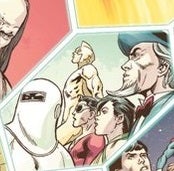
The world where Uncle Sam and his Freedom Fighters lived was another of the worlds folded into what eventually became the post-Crisis on Infinite Earths DC Universe.
Many of the characters of Earth-X felt a bit dated, and since the whole setup was that Nazis had won the war, some of them didn’t work at all in the context of a more familiar version of US history. As such, many of them had a hard time connecting with readers over the years and DC has tried and failed to reinvent the wheel with these guys quite a few times.
Like Captain Carrot and company, though, they always pop up when the Multiverse is at stake.

Kamandi and the intelligent animals that inhabited his world were last seen in The New 52: Futures End: Booster Gold #1, in which Booster was bounced around various worlds included on this list.
He spent comparably little time on Earth-Four and the pre-Flashpoint Earth, though, as compared to Kamandi’s dystopian future.
The world, created by Jack Kirby, started as a pitch to do a Planet of the Apes story and when the rights were tied up elsewhere, just became its own thing with some similar visuals and concepts. The artistry, scope and madness of it, though, was pure Kirby and it’s gone on to be one of his most beloved DC projects.
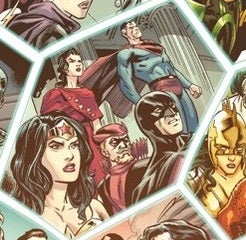
Possibly the most popular, and certainly one of the most often-returned-to Elseworlds stories of all time, Mark Waid and Alex Ross’s Kingdom Come told the story of a world about thirty years in the future, dealing with a re-formed Justice League after a massive global crisis forces Superman out of a self-imposed retirement and Antarctic exile.
That the story ended with Superman and Wonder Woman having a baby (Lois was dead, after all…) gave a lot of people ideas as to what the next generation of that universe would look like, but both Waid’s The Kingdom and Ross’s Thy Kingdom Come storylines dealt with the multiverse in different ways. Not surprising, then, to see these characters popping up here.
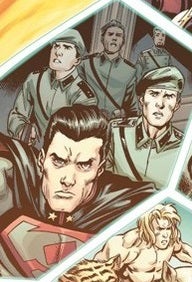
Another Elseworlds story that’s positively evergreen for DC is Mark Millar’s Superman: Red Son. Set on a world where Superman’s rocket crashed in Soviet Russia, the story became one of DC’s first motion comics sold through iTunes and is so popular to this day that when Mark Millar recently teased a loosely-pencilled prequel for Jupiter’s Legacy, a lot of fans (and we) thought he was working on a Red Son sequel instead.
It was one of a number of worlds that was seen in the post-52 multiverse, but what’s odder is that it’s specifically on the Multiverse Map circulated ahead of The Multiversity. We’re starting to wonder if that whole “these worlds are dead” thing might have been USA Today overstating a case.
This one, of course, shares some DNA with Earth-X, in that the big “difference” in it isn’t so much about the superheroes as it is geopolitics that divide it from the “real” world.
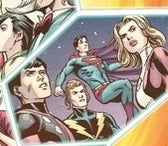
Is this the old Earth-1, maybe? After the Crisis on Infinite Earths, Superman hadn’t been Superboy, so he didn’t ever meet up with the Legion of Super-Heroes.
As somebody who doesn’t have a ton of expertise with the Legion, I can’t tell for sure which version of the often-rebooted futuristic teen superteam this is meant to be. Maybe somebody can come into the credits and let us know?








